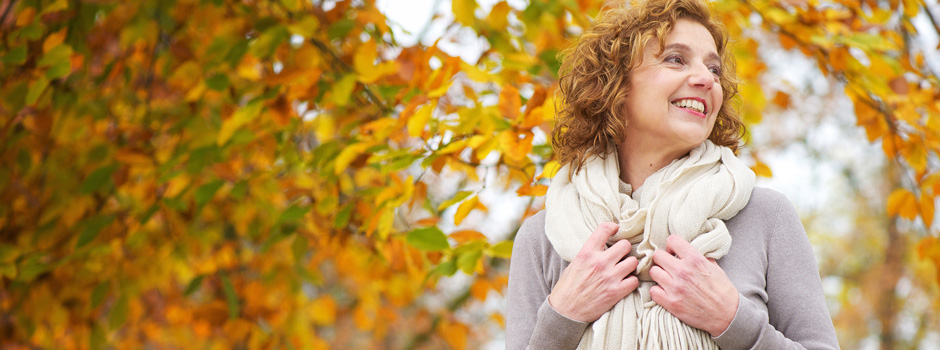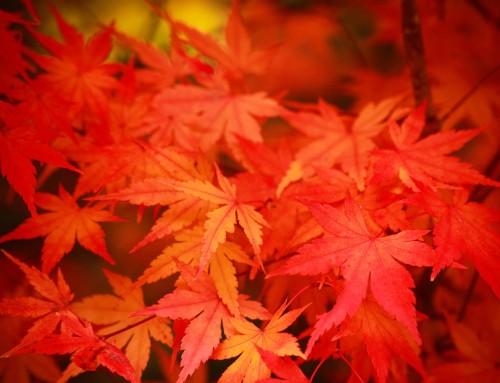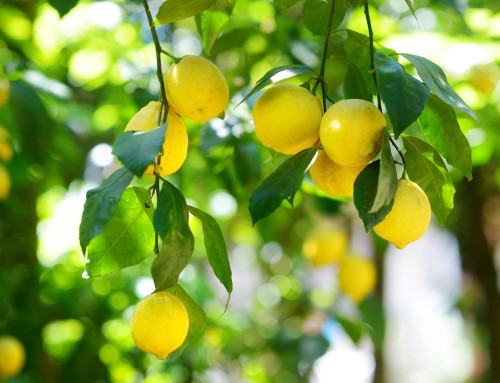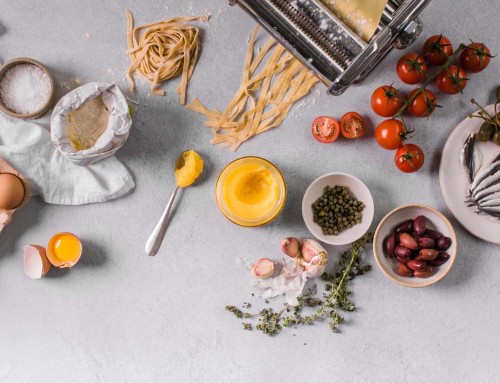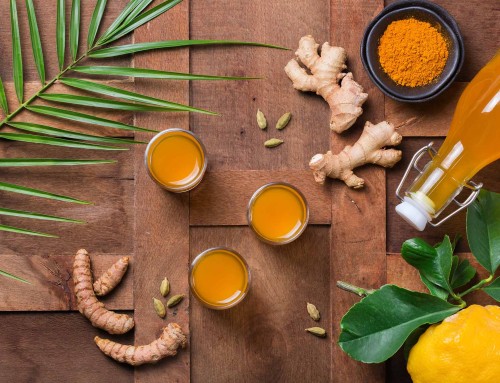Now the cold weather is here many of us can start to suffer from colds, flu and fever. We will look at the Ayurvedic understanding of how these conditions arise and how to deal with them. Along the way you will find some hints on how to avoid these conditions in the first place.
Ayurveda sees flu, fever, coughs and colds as resulting from:
- wrong diet,
- disturbed digestion,
- inappropriate lifestyle,
- being overactive and too busy.
Ama makes us weak and Ojas makes us strong
Anything that causes Ama – a toxic build-up caused by partially digested food – will make us vulnerable to fever, coughs and colds. In fact, this toxic build-up will provide the perfect environment for viruses to thrive.
If poor digestion of food causes low immunity, good digestion strengthens our immune system. Ayurveda states that a subtle yet highly important tissue called Ojas, which is responsible for our strength and immunity, is the direct product of successful digestion.
Anything which burns up Ojas, such as being stressed or indulging in excessive sensuality, weakens our immunity and leaving us more susceptible to viral infections.
How mind can create toxic matter
Ayurveda states that when we allow anger, envy, hatred, criticism or judgementalism to dominate our mind, it becomes overheated and fevered. It can also become fevered when we fall in love.
A fevered mind is overactive, unbalanced and confused, and in this state we usually make wrong choices. We choose the wrong foods, eat the wrong amount and eat at the wrong times. This has a negative impact on our digestive fire – we don’t digest our food properly and the result is the accumulation of toxic Ama.
Toxic mixture of Ama with the Doshas
Vata Dosha is the element in our physiology that is responsible for movement. Pitta Dosha is responsible for transformation and digestion. Kapha Dosha is responsible for the strength and structure of our body. Vata, Pitta and Kapha each have several sub-Doshas located in different parts of our body.
A sub-Dosha of Vata, called Samana Vata, is found in the gut and it governs absorption and metabolism. When we are in the imbalanced state, described previously, Samana Vata pushes Ama and Pachaka Pitta (a sub-Dosha of Pitta that governs digestive fire) out of the stomach and into our tissues.
One consequence of this is less digestive fire in our stomach and a loss of appetite.
When this toxic mixture of Ama with Pachaka Pitta is pushed out from the stomach into the body tissues, the sticky quality of the Ama will upset the normal functioning of those tissues. The clogging effect of Ama will restrict both nourishment from entering the tissues and waste matter from being eliminated.
The heating effect of Pachaka Pitta, which has mixed in with the Ama, can start to overheat the tissues and create fever symptoms.
The effect of both actions will result in aching and inflammation in the tissues. Fatigue and exhaustion will also be felt.
[fusion_builder_container hundred_percent="no" equal_height_columns="no" menu_anchor="" hide_on_mobile="small-visibility,medium-visibility,large-visibility" class="" id="" background_color="" background_image="" background_position="center center" background_repeat="no-repeat" fade="no" background_parallax="none" parallax_speed="0.3" video_mp4="" video_webm="" video_ogv="" video_url="" video_aspect_ratio="16:9" video_loop="yes" video_mute="yes" overlay_color="" video_preview_image="" border_size="" border_color="" border_style="solid" padding_top="" padding_bottom="" padding_left="" padding_right=""][fusion_builder_row][fusion_builder_column type=”1_1″ layout=”1_1″ background_position=”left top” background_color=”” border_size=”” border_color=”” border_style=”solid” border_position=”all” spacing=”yes” background_image=”” background_repeat=”no-repeat” padding_top=”” padding_right=”” padding_bottom=”” padding_left=”” margin_top=”0px” margin_bottom=”0px” class=”” id=”” animation_type=”” animation_speed=”0.3″ animation_direction=”left” hide_on_mobile=”small-visibility,medium-visibility,large-visibility” center_content=”no” last=”no” min_height=”” hover_type=”none” link=””][fusion_text]
[fusion_separator style_type="none" hide_on_mobile="small-visibility,medium-visibility,large-visibility" class="" id="" sep_color="" top_margin="6" bottom_margin="6" border_size="0" icon="" icon_circle="" icon_circle_color="" width="" alignment="center"][/fusion_separator]
Different kinds of internal fever
Fever can be due to imbalances in Vata, Pitta or Kapha, or imbalances in mixtures of these Doshas. Ayurveda recognises an internal fever when there is no rise in temperature and yet there is a feeling of malaise, muscle ache and headache. Such localised fevers can be seen as inflammatory conditions than can occur in certain parts of the body.
Kapha fever
Fever due to Kapha originates in the stomach, with Kapha, mixed with Ama, spreading out into other body tissues.
Stage 1: If we eat an excess of Kapha promoting foods, such as ice cream and cakes for example, Kapha Dosha will accumulate in the stomach. This is the first stage of digestive problems associated with Kapha. At this stage we could nip the disease process in the bud. If we sipped a little hot water, chewed a few digestive spices, such as root ginger and fennel, and if we went out for a good walk, we would aid in the digestion of the Kapha-promoting food and probably avoid any further problems.
Stage 2: If, instead, we sat on the sofa, watched some TV, and had a cup of sweet tea with a few biscuits, the second stage of Kapha disturbance would probably set in – the provoking of Kapha leading to interference in the digestive process. This interference will cause partially digested food to accumulate in the digestive tract and then lead to the build up of toxic Ama.
Stage 3: In the third stage the resulting Ama, mixed in with excess Kapha, is pushed into a tissue called Rasa, which is the first of our body tissues. At this point fever symptoms may result.
Because Kapha is involved, the malaise may bring up feelings of greed and attachment. Paleness of the skin can also result.
This type of Kapha disturbance often results in colds, cough and congestion. Symptoms, such runny nose, chills, no appetite and excess salivation, are usually present, yet temperature is not usually that high.
Pitta fever
A Pitta fever starts in the small intestines, which is the seat of Pitta. I could be, you have eaten too many hot curries. Maybe you have become involved in some heated argument. Perhaps you have been on holiday in a hot climate and become overheated. In each cases, digestion will be disturbed. At the same time Pitta will start accumulating, particularly in parts of your body which are hot by nature, such as the liver and small intestines.
In almost all disease processes, their origins are in disturbed digestion and in the creation of Ama. In the case of Pitta-fever this build-up of Ama is accompanied by a build-up of Pitta – and eventually this excess Pitta will mix with Ama. From the small intestines this toxic mixture of Pitta and Ama gets pushed out into the body tissues.
Symptoms of Pitta fever can include your skin appearing flushed and the eyes bloodshot. There may be associated anger and irritation. There is likely to be increased sweating and temperature is likely to be high. Along with headache, there may also be nausea, vomiting, diarrhoea, and dark yellow urine.
Vata fever
Fear, anxiety, too much change in your life, too much cold and dry food, or cold and windy weather can all increase Vata Dosha in your body. An over accumulation of Vata, along with disturbed digestion, can lead to Vata fever. A Vata fever starts in the colon. Fear and anger may be experienced during the fever. Symptoms may include a dark complexion, frequent yawning, goose pimples, shivering, constipation, muscle stiffness, body ache, joint pains and ringing in the ears.
[fusion_builder_container hundred_percent="no" equal_height_columns="no" menu_anchor="" hide_on_mobile="small-visibility,medium-visibility,large-visibility" class="" id="" background_color="" background_image="" background_position="center center" background_repeat="no-repeat" fade="no" background_parallax="none" parallax_speed="0.3" video_mp4="" video_webm="" video_ogv="" video_url="" video_aspect_ratio="16:9" video_loop="yes" video_mute="yes" overlay_color="" video_preview_image="" border_size="" border_color="" border_style="solid" padding_top="" padding_bottom="" padding_left="" padding_right=""][fusion_builder_row][fusion_builder_column type=”1_1″ layout=”1_1″ background_position=”left top” background_color=”” border_size=”” border_color=”” border_style=”solid” border_position=”all” spacing=”yes” background_image=”” background_repeat=”no-repeat” padding_top=”” padding_right=”” padding_bottom=”” padding_left=”” margin_top=”0px” margin_bottom=”0px” class=”” id=”” animation_type=”” animation_speed=”0.3″ animation_direction=”left” hide_on_mobile=”small-visibility,medium-visibility,large-visibility” center_content=”no” last=”no” min_height=”” hover_type=”none” link=””][fusion_text]

[fusion_separator style_type="none" hide_on_mobile="small-visibility,medium-visibility,large-visibility" class="" id="" sep_color="" top_margin="6" bottom_margin="6" border_size="0" icon="" icon_circle="" icon_circle_color="" width="" alignment="center"][/fusion_separator]
Different kinds of internal fever
Fever can be due to imbalances in Vata, Pitta or Kapha, or imbalances in mixtures of these Doshas. Ayurveda recognises an internal fever when there is no rise in temperature and yet there is a feeling of malaise, muscle ache and headache. Such localised fevers can be seen as inflammatory conditions than can occur in certain parts of the body.
Kapha fever
Fever due to Kapha originates in the stomach, with Kapha, mixed with Ama, spreading out into other body tissues.
Stage 1: If we eat an excess of Kapha promoting foods, such as ice cream and cakes for example, Kapha Dosha will accumulate in the stomach. This is the first stage of digestive problems associated with Kapha. At this stage we could nip the disease process in the bud. If we sipped a little hot water, chewed a few digestive spices, such as root ginger and fennel, and if we went out for a good walk, we would aid in the digestion of the Kapha-promoting food and probably avoid any further problems.
Stage 2: If, instead, we sat on the sofa, watched some TV, and had a cup of sweet tea with a few biscuits, the second stage of Kapha disturbance would probably set in – the provoking of Kapha leading to interference in the digestive process. This interference will cause partially digested food to accumulate in the digestive tract and then lead to the build up of toxic Ama.
Stage 3: In the third stage the resulting Ama, mixed in with excess Kapha, is pushed into a tissue called Rasa, which is the first of our body tissues. At this point fever symptoms may result.
Because Kapha is involved, the malaise may bring up feelings of greed and attachment. Paleness of the skin can also result.
This type of Kapha disturbance often results in colds, cough and congestion. Symptoms, such runny nose, chills, no appetite and excess salivation, are usually present, yet temperature is not usually that high.
Pitta fever
A Pitta fever starts in the small intestines, which is the seat of Pitta. I could be, you have eaten too many hot curries. Maybe you have become involved in some heated argument. Perhaps you have been on holiday in a hot climate and become overheated. In each cases, digestion will be disturbed. At the same time Pitta will start accumulating, particularly in parts of your body which are hot by nature, such as the liver and small intestines.
In almost all disease processes, their origins are in disturbed digestion and in the creation of Ama. In the case of Pitta-fever this build-up of Ama is accompanied by a build-up of Pitta – and eventually this excess Pitta will mix with Ama. From the small intestines this toxic mixture of Pitta and Ama gets pushed out into the body tissues.
Symptoms of Pitta fever can include your skin appearing flushed and the eyes bloodshot. There may be associated anger and irritation. There is likely to be increased sweating and temperature is likely to be high. Along with headache, there may also be nausea, vomiting, diarrhoea, and dark yellow urine.
Vata fever
Fear, anxiety, too much change in your life, too much cold and dry food, or cold and windy weather can all increase Vata Dosha in your body. An over accumulation of Vata, along with disturbed digestion, can lead to Vata fever. A Vata fever starts in the colon. Fear and anger may be experienced during the fever. Symptoms may include a dark complexion, frequent yawning, goose pimples, shivering, constipation, muscle stiffness, body ache, joint pains and ringing in the ears.
[fusion_builder_container hundred_percent="no" equal_height_columns="no" menu_anchor="" hide_on_mobile="small-visibility,medium-visibility,large-visibility" class="" id="" background_color="" background_image="" background_position="center center" background_repeat="no-repeat" fade="no" background_parallax="none" parallax_speed="0.3" video_mp4="" video_webm="" video_ogv="" video_url="" video_aspect_ratio="16:9" video_loop="yes" video_mute="yes" overlay_color="" video_preview_image="" border_size="" border_color="" border_style="solid" padding_top="" padding_bottom="" padding_left="" padding_right=""][fusion_builder_row][fusion_builder_column type=”1_1″ layout=”1_1″ background_position=”left top” background_color=”” border_size=”” border_color=”” border_style=”solid” border_position=”all” spacing=”yes” background_image=”” background_repeat=”no-repeat” padding_top=”” padding_right=”” padding_bottom=”” padding_left=”” margin_top=”0px” margin_bottom=”0px” class=”” id=”” animation_type=”” animation_speed=”0.3″ animation_direction=”left” hide_on_mobile=”small-visibility,medium-visibility,large-visibility” center_content=”no” last=”no” min_height=”” hover_type=”none” link=””][fusion_text]
[/fusion_text][fusion_separator style_type="none" hide_on_mobile="small-visibility,medium-visibility,large-visibility" class="" id="" sep_color="" top_margin="6" bottom_margin="6" border_size="0" icon="" icon_circle="" icon_circle_color="" width="" alignment="center" /][/fusion_builder_column][fusion_builder_column type=”1_2″ layout=”1_2″ last=”no” min_height=”” hover_type=”none” link=”” border_position=”all”][fusion_text]
Ayurvedic ways to treat colds and flu
The first rule when you have cold, flu or fever, is to take plenty of rest and bundle yourself up with blankets.
Fasting
The primary treatment for colds, flu and fever is fasting. During such illnesses, your appetite is usually low and this is a good indication that your body needs a rest from food. When digestive fire is low, even a small amount more your stomach, than it can cope with, will quickly produce more Ama – and that is the last thing you need.
Fasting will give your body the chance to detoxify the Ama and excess Doshas that have accumulated in your tissues. Ayurvedic fasting means light soups for each meal. A small amount of fruit is also suitable; though avoid heavy fruits, such as bananas and avocados. Avoid any fruits that are sour, apart from a little lemon or lime juice. Cooked fruits, such as stewed apples, are easier on the digestion than raw fruits.
To tea or not to tea
A Kapha person should take very little by mouth if they suffer from colds, flu or fever. Vata and Pitta people may find themselves dehydrated during these conditions. For them, a good tea to take will consist of equal proportions of ginger, basil, lemongrass and fennel. Steep the ingredients for ten minutes in hot water. Ginger and fennel burn Ama and ginger promotes your digestive fire. Lemongrass prevents fever and causes sweating. Basil is a decongestant and reduces fever.
Do not bathe during fever
Do not take a bath during these conditions. If you are suffering from fever, sponging with tepid water will reduce it, but postpone bathing until you recover. When you are over the worst of the illness, a shower will be fine.
What to eat when you are ill in bed
If you are ill enough to have to be in bed, avoid meat, as your digestive fire will be too low to cope with it. For the same reason, do not use oil either externally or by mouth. Once you start to recover, and your appetite improves, you can drink warm rice water drained from well-cooked rice. Rice water is highly nourishing, yet it is undemanding on your digestive fire.
As your appetite gets stronger start to eat soups and gradually return to normal diet. From then on your diet should be adjusted to balance whatever Doshas is still out of balance – Vata, Pitta or Kapha.
Vata bed-rest: For a Vata fever rest and warmth are most important – use plenty of blankets and keep the room warm. Even under the blankets a Vata person may shiver and feel cold.
Pitta bed-rest: For a person suffering from Pitta fever, a darkened room may help as light can bother them. A warm room is advised, but a Pitta person may throw off blankets and suffer more from fever symptoms than those who have either Vata or Kapha fevers. Because of this, light bedding is recommended. If there is very high fever, a sponge-down with tepid rosewater is useful. If there is no sensitivity to camphor, some camphor mixed with cool water can be applied on a cloth to the forehead.
Kapha bed-rest: For a Kapha fever, rest and heat are recommended. Food should be restricted and hot spices avoided. A valuable tea for Kapha fever consists of fennel, cumin and coriander in equal proportions. Steep the herbs in hot water for ten minutes and drink while still hot.
Early signs of colds and flu
Early signs of colds and flu are low appetite and feverishness. There is loss of interest and appetite for anything – the charm in life is somehow missing. You will feel exhausted and fatigued. There may be loss of taste for food.
- Dark colouration, frequent yawning and goose pimples may occur for Vata body types.
- Dizziness, hot flushes, burning sensations may occur, and the skin may appear flushed in Pitta body types.
- Pallor, chills, runny nose and loss of appetite, is often present in those who are predominantly Kapha.
- Be careful to eat good quality food and take good care of your digestion.
- Don’t eat too much at mealtimes and always leave your meal feeling satisfied but not completely full.
- Only eat when you feel truly hungry.
How to prevent colds and flu
Following these simple rules will help prevent Ama from forming and keep the Doshas from going out of balance.
A regular routine and a reasonably stress-free life will help keep your immune system on top form. Stressful activity, done in a hurry, is the worst thing for burning up your Ojas and compromising your immunity.
Strengthening your Ojas – the key to good health
To produce a good amount of Ojas, and strengthen your immunity on an on-going basis, try the following:
- Choose easy-to-digest, organic, foods.
- Including fresh fruits, vegetables, whole grains, legumes and light dairy products.
- Cook with immune-boosting spices – fennel, cumin, black pepper, turmeric, coriander, cinnamon, and ginger.
- Eat immune-boosting foods like apples, sweet, juicy fruits, pomegranate juice, leafy greens, whole grains, ghee and boiled organic milk.
- Gently cook your foods.
- Include a small amount of ghee in each meal.
- Take care of your digestion.
- Eat according to your nature and the season.
[/fusion_text][fusion_separator style_type="none" hide_on_mobile="small-visibility,medium-visibility,large-visibility" class="" id="" sep_color="" top_margin="6" bottom_margin="6" border_size="0" icon="" icon_circle="" icon_circle_color="" width="" alignment="center" /][/fusion_builder_column][fusion_builder_column type=”1_2″ layout=”1_2″ last=”no” min_height=”” hover_type=”none” link=”” border_position=”all”][fusion_text]
Ayurvedic ways to treat colds and flu
The first rule when you have cold, flu or fever, is to take plenty of rest and bundle yourself up with blankets.
Fasting
The primary treatment for colds, flu and fever is fasting. During such illnesses, your appetite is usually low and this is a good indication that your body needs a rest from food. When digestive fire is low, even a small amount more your stomach, than it can cope with, will quickly produce more Ama – and that is the last thing you need.
Fasting will give your body the chance to detoxify the Ama and excess Doshas that have accumulated in your tissues. Ayurvedic fasting means light soups for each meal. A small amount of fruit is also suitable; though avoid heavy fruits, such as bananas and avocados. Avoid any fruits that are sour, apart from a little lemon or lime juice. Cooked fruits, such as stewed apples, are easier on the digestion than raw fruits.
To tea or not to tea
A Kapha person should take very little by mouth if they suffer from colds, flu or fever. Vata and Pitta people may find themselves dehydrated during these conditions. For them, a good tea to take will consist of equal proportions of ginger, basil, lemongrass and fennel. Steep the ingredients for ten minutes in hot water. Ginger and fennel burn Ama and ginger promotes your digestive fire. Lemongrass prevents fever and causes sweating. Basil is a decongestant and reduces fever.
Do not bathe during fever
Do not take a bath during these conditions. If you are suffering from fever, sponging with tepid water will reduce it, but postpone bathing until you recover. When you are over the worst of the illness, a shower will be fine.
What to eat when you are ill in bed
If you are ill enough to have to be in bed, avoid meat, as your digestive fire will be too low to cope with it. For the same reason, do not use oil either externally or by mouth. Once you start to recover, and your appetite improves, you can drink warm rice water drained from well-cooked rice. Rice water is highly nourishing, yet it is undemanding on your digestive fire.
As your appetite gets stronger start to eat soups and gradually return to normal diet. From then on your diet should be adjusted to balance whatever Doshas is still out of balance – Vata, Pitta or Kapha.
Vata bed-rest: For a Vata fever rest and warmth are most important – use plenty of blankets and keep the room warm. Even under the blankets a Vata person may shiver and feel cold.
Pitta bed-rest: For a person suffering from Pitta fever, a darkened room may help as light can bother them. A warm room is advised, but a Pitta person may throw off blankets and suffer more from fever symptoms than those who have either Vata or Kapha fevers. Because of this, light bedding is recommended. If there is very high fever, a sponge-down with tepid rosewater is useful. If there is no sensitivity to camphor, some camphor mixed with cool water can be applied on a cloth to the forehead.
Kapha bed-rest: For a Kapha fever, rest and heat are recommended. Food should be restricted and hot spices avoided. A valuable tea for Kapha fever consists of fennel, cumin and coriander in equal proportions. Steep the herbs in hot water for ten minutes and drink while still hot.
Early signs of colds and flu
Early signs of colds and flu are low appetite and feverishness. There is loss of interest and appetite for anything – the charm in life is somehow missing. You will feel exhausted and fatigued. There may be loss of taste for food.
- Dark colouration, frequent yawning and goose pimples may occur for Vata body types.
- Dizziness, hot flushes, burning sensations may occur, and the skin may appear flushed in Pitta body types.
- Pallor, chills, runny nose and loss of appetite, is often present in those who are predominantly Kapha.
- Be careful to eat good quality food and take good care of your digestion.
- Don’t eat too much at mealtimes and always leave your meal feeling satisfied but not completely full.
- Only eat when you feel truly hungry.
How to prevent colds and flu
Following these simple rules will help prevent Ama from forming and keep the Doshas from going out of balance.
A regular routine and a reasonably stress-free life will help keep your immune system on top form. Stressful activity, done in a hurry, is the worst thing for burning up your Ojas and compromising your immunity.
Strengthening your Ojas – the key to good health
To produce a good amount of Ojas, and strengthen your immunity on an on-going basis, try the following:
- Choose easy-to-digest, organic, foods.
- Including fresh fruits, vegetables, whole grains, legumes and light dairy products.
- Cook with immune-boosting spices – fennel, cumin, black pepper, turmeric, coriander, cinnamon, and ginger.
- Eat immune-boosting foods like apples, sweet, juicy fruits, pomegranate juice, leafy greens, whole grains, ghee and boiled organic milk.
- Gently cook your foods.
- Include a small amount of ghee in each meal.
- Take care of your digestion.
- Eat according to your nature and the season.
[/fusion_text][/fusion_builder_column][fusion_builder_column type=”1_2″ layout=”1_2″ last=”yes” min_height=”” hover_type=”none” link=”” border_position=”all”][fusion_text]
Herbal remedies to prevent colds and flu
The following Maharishi Ayurveda herbal preparations will help your digestion during illness and both help prevent and eliminate the build-up of Ama:
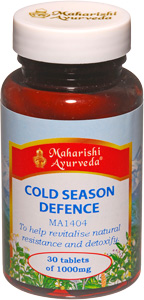 Cold Season Defence
Cold Season Defence
Ama is a toxic waste caused by undigested food that can accumulate in your body and weaken its immune defences. Ama thereby provides a fertile ground for viruses to grow. Cold Season Defence offers nutritional support, during the winter season, and it contains a specific blend of herbs to removes deep-seated Ama.
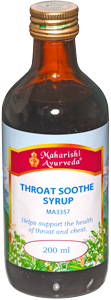
Throat Soothe Syrup
The throat and respiratory system are mainly controlled by Kapha Dosha. When Kapha becomes out of balance impurities can build up and this area can become prone to infection. This can result in throat infections, occasional coughs and over-production of phlegm. Working in synergy, the 17 other ingredients, Throat Soothe syrup helps soothe and cool the respiratory system. This balanced Ayurvedic formulas helps to cleanse the throat and chest of impurities. It helps reduce excess phlegm and it helps calm coughing fits.
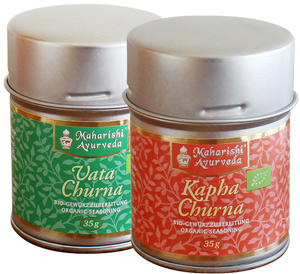 Vata Churna and Kapha Churna spice mixes
Vata Churna and Kapha Churna spice mixes
Both of these churnas (powders) consists of a specially blended spice mix suitable for balancing either Vata or Kapha Doshas. If you have these two in your cupboard you can use them during cold season to keep your body in balance. During cold, dry, windy weather Vata Churna helps to soothe and lubricate the throat and respiratory system. During cold, wet weather Kapha Churna helps to keep your body channels open, the digestion in good condition and it helps purify Ama (internally created toxins), the basis of most infectious disease, according to Ayurveda.
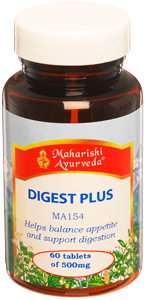 Digest Plus
Digest Plus
Digest Plus increases digestive fire or Agni. It improves your appetite and supports digestion. It helps balance stomach acid, helps prevent production of excess gas and supports both liver and pancreas. Digest Plus detoxifies Ama from your body tissues and is particularly suitable to take after a heavy meal.
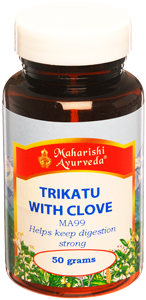 Trikatu with Clove
Trikatu with Clove
Trikatu with Clove is a stronger digestive aid than Digest plus and very useful before or after a heavy meal. It consists of four strongly pungent spices – ginger, black pepper, Indian long pepper and cloves and is an important combination used by itself and in many Ayurvedic formulations for its
cleansing, digestive, and stimulating effects. Trikatu supports the health of stomach and GI tract and upper respiratory tract. Its stimulates the secretion of digestive juices, increases appetite and balances gas in the stomach.
Triphala with Rose
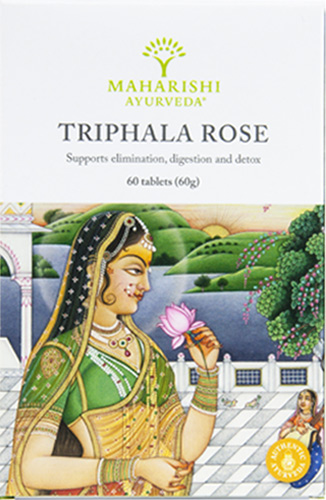 Lack of appetite for a meal is usually the result of the incomplete digestion of previous meals. It can also indicate a build-up of Ama, or partially digested food that has become toxic to your system. Triphala consists of three fruits, which work synergistically to tone and detoxify your entire digestive tract. Cabbage Rose is added to support and enhance the other ingredients. Besides helping you detox, Triphala Rose enlivens your ability to absorb nutrients effectively and helps maintain your health and energy.
Lack of appetite for a meal is usually the result of the incomplete digestion of previous meals. It can also indicate a build-up of Ama, or partially digested food that has become toxic to your system. Triphala consists of three fruits, which work synergistically to tone and detoxify your entire digestive tract. Cabbage Rose is added to support and enhance the other ingredients. Besides helping you detox, Triphala Rose enlivens your ability to absorb nutrients effectively and helps maintain your health and energy.
Herbal remedies to prevent colds and flu
The following Maharishi Ayurveda herbal preparations will help your digestion during illness and both help prevent and eliminate the build-up of Ama:


